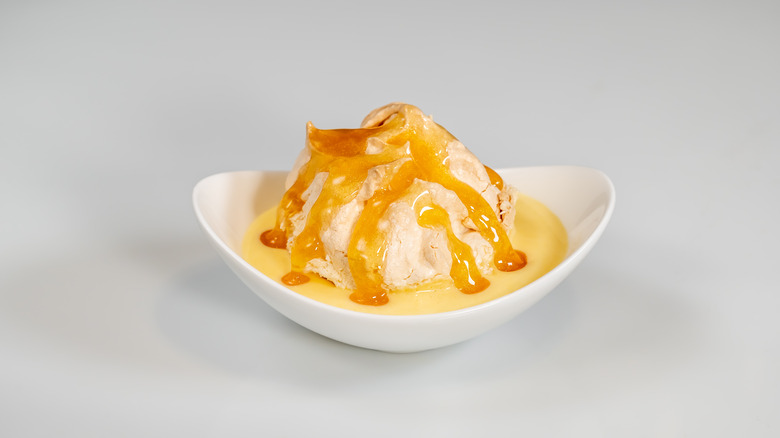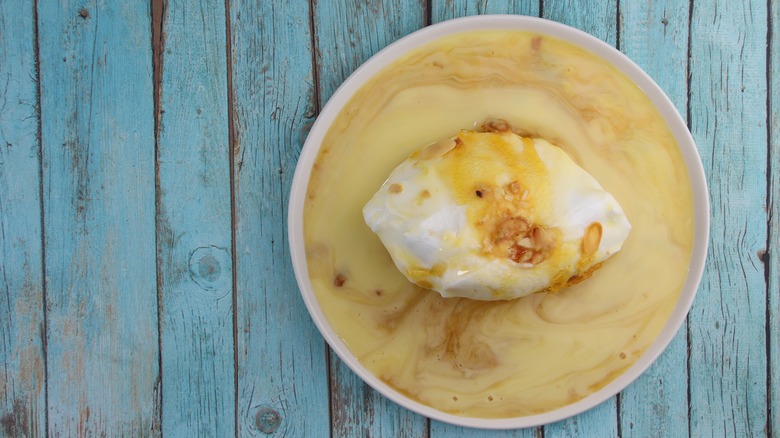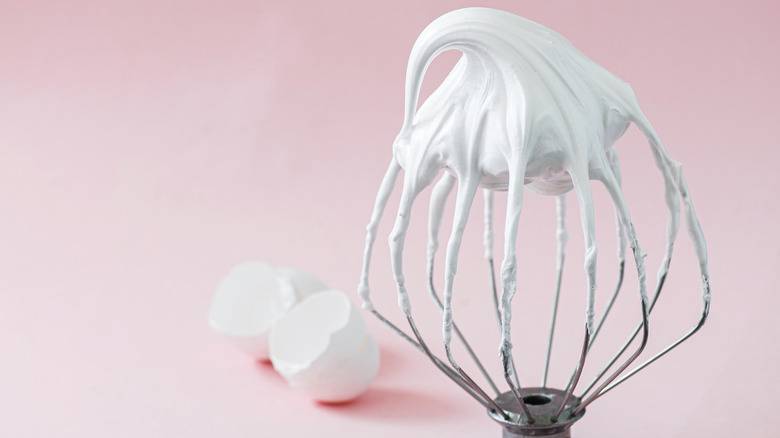Floating Islands: The Whimsical Dessert That's Worth The Effort
Since food tourism is having a moment right now, ever taken a trip to the islands? How about the Floating Islands? If not, foodies with a sweet tooth should book their tickets right this second.
In case you haven't heard of it, introducing Floating Islands: The whimsical dessert that's worth the effort. Floating Islands are famously (perhaps the most famous thing about them, actually) one of Julia Child's self-professed favorite desserts, per Taste of Home. It's also a favorite of esteemed pastry chef David Lebovitz. "People either love it or hate it," Lebowitz admits, via Eater, but for folks who dig it, the dish's complicated preparation is a small price to pay for the finished product.
Floating Islands are tasty, but the dessert's real appeal comes from its impressive presentation. According to the BBC, the dessert consists of one or multiple "islands" made from stiffly-beaten meringue "floating" in crème anglaise vanilla custard. It's served chilled and often drizzled with caramel sauce. The cooking process is elaborate and multi-stepped — for fans of The Great British Baking Show, Floating Islands were the technical challenge in Season 2's "Desserts" episode, per PBS. But, the dessert only takes an hour to put together and doesn't require any special equipment beyond what can be found in a common home kitchen.
An English version of a French delicacy
Per Food52, Floating Islands first popped up in culinary history in 1747 via the "Oxford Companion to Food," in which they were listed as "Flooting Islands." The dessert is a modified English version of the French dish "île flottante." The French iteration is similar, consisting of egg yolks on top of beaten egg whites. But, in Floating Islands, the egg yolk takes the form of custard, and the egg whites get milk-poached and act as the topping. The dessert also might have evolved from the French "snow eggs," aka "oeufs à la neige."
While, in its simplest form, Floating Islands is a light, airy dessert, other toppings can be added for a pleasant textural component. The dessert is nearly always topped with caramel sauce, spun sugar, or some form of sugar art, says Taste of Home, which lends a crunch. Fittingly delicate garnishes like fresh tart raspberries, pistachios, or slivered almonds are common. Food Network even suggests garnishing with rose petals crystallized in sugar. So, how do you make Floating Islands? Word of warning: It takes a lot of steps.
Hang in there -- we're on island time now
To set sail to the Floating Islands, first crack your egg whites into a bowl and allow them to get to room temperature. Then, whisk egg yolks, sugar, cornstarch, and milk in a saucepan, stirring until it's thick enough to coat your whisk but not long enough that it begins to boil, says Taste of Home. Strain the mixture through a sieve into a metal bowl, then stir in a little vanilla and transfer the bowl to the fridge to set up. You've just made your crème anglaise — and you're only halfway done with the dessert.
Now, it's time for the meringue. Grab those egg whites from earlier and hit 'em with some cream of tartar or caster sugar, per the BBC. Then, beat in sugar and vanilla until stiff peaks begin to form. Dollop a few heaping spoonfuls of the meringue into a hot saucepan full of milk and poach them over low heat until they're firm enough to hold their shape. Then, you can gently set your meringue islands on top of that custard sea, drizzle on the caramel sauce and/or garnish, and you've got a Floating Island worth of Julia Child herself.
Cognac, Grand Marnier, or Harlequin Orange liqueurs are also sometimes added for flavor, via Mashed. To offset the dessert's sweetness, The Seattle Times suggests incorporating pureed fresh apricots into your crème anglaise for a little tartness.


